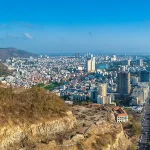Introducing Peru’s Traditional Dishes
If you want to taste your way through one of the world’s most exciting food destinations without spending hours on research, this is your guide. Inside, you’ll find our curated list of the best food in Peru, with concise descriptions to help you decide what to try and where to find it.
We’ve also added a downloadable interactive PDF checklist at the end—perfect for tracking each dish you sample and noting your personal impressions.
Want to explore the history, cooking techniques, and cultural influences behind Peruvian cuisine? Check out our full “Culinary Guide to Peru” on the website.
Table of Contents
Pet Alert
Peruvian menus feature cuy (guinea pig), the same whiskered buddy many keep as a pet.
If you’re sensitive to that, proceed with care.
Best Food to Try in Peru: Main Dishes
1. Aji de Gallina (Creamy Chicken)
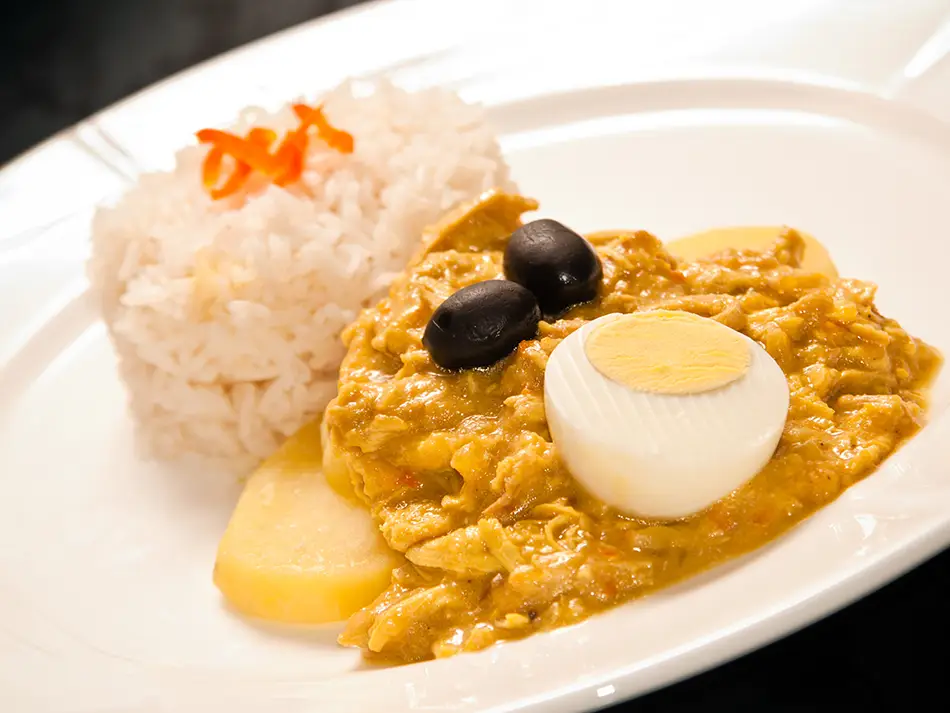
This dish features shredded chicken in a creamy, savory sauce. The sauce’s distinctive yellow color and mild heat come from aji amarillo, a Peruvian yellow chili pepper with a fruity flavor. It is typically blended with bread, milk, and nuts to create a thick consistency. Aji de Gallina is commonly served over rice with boiled potatoes and garnished with a black olive and a slice of hard-boiled egg.
2. Arroz con Pato (Duck Rice)
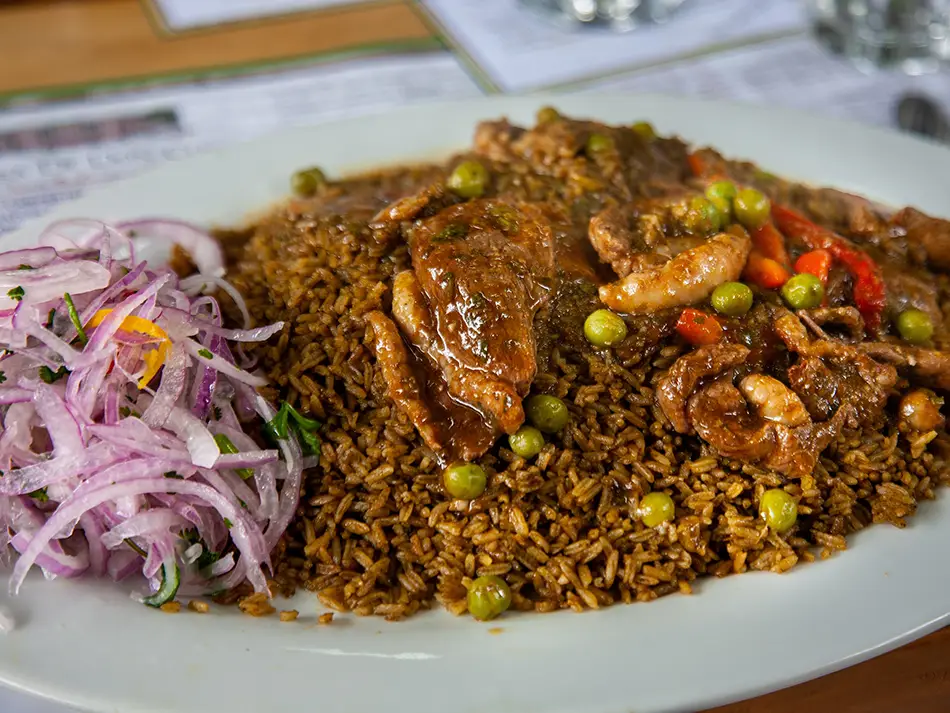
A classic dish from the northern coast, Arroz con Pato translates to “rice with duck.” The rice is cooked in a rich stock made with dark beer and cilantro, which gives it a deep green color and complex flavor profile. A piece of tender, pan-seared or roasted duck is served on top of or alongside the flavorful rice.
3. Carapulcra (Pork And Potato Stew)
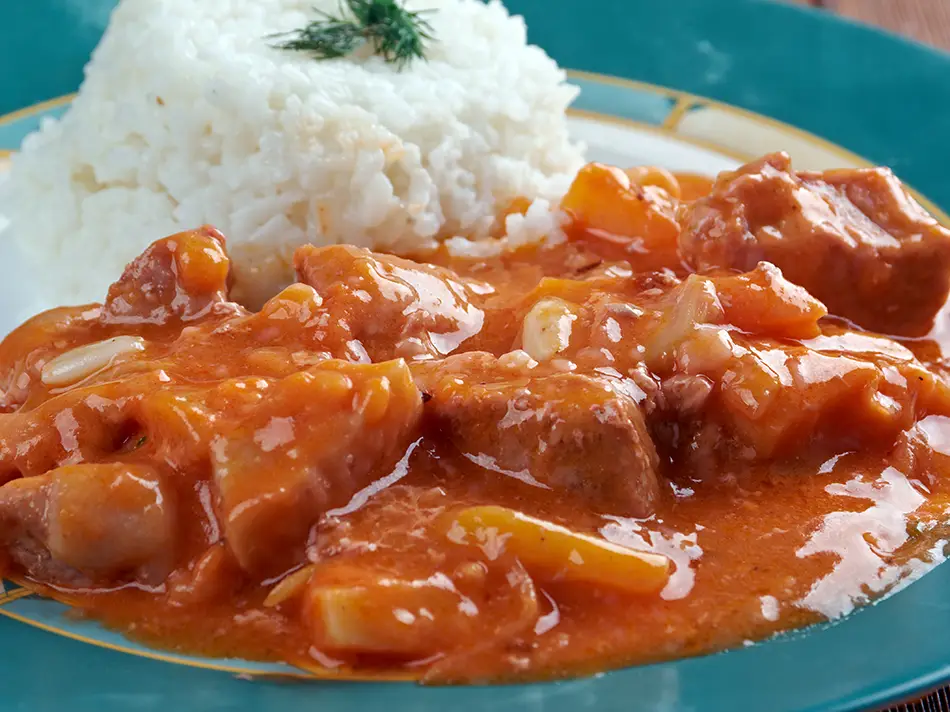
This is an ancient Andean stew with roots dating back to the Inca Empire. It is made from papa seca, which is dehydrated and rehydrated potato, giving the dish a unique, hearty texture. The stew is slow-cooked with pork or chicken, aji panca (a smoky red chili pepper), peanuts, and various spices. It is a substantial and warming meal, often served with rice.
4. Chiriuchu (Cold Festival Platter)
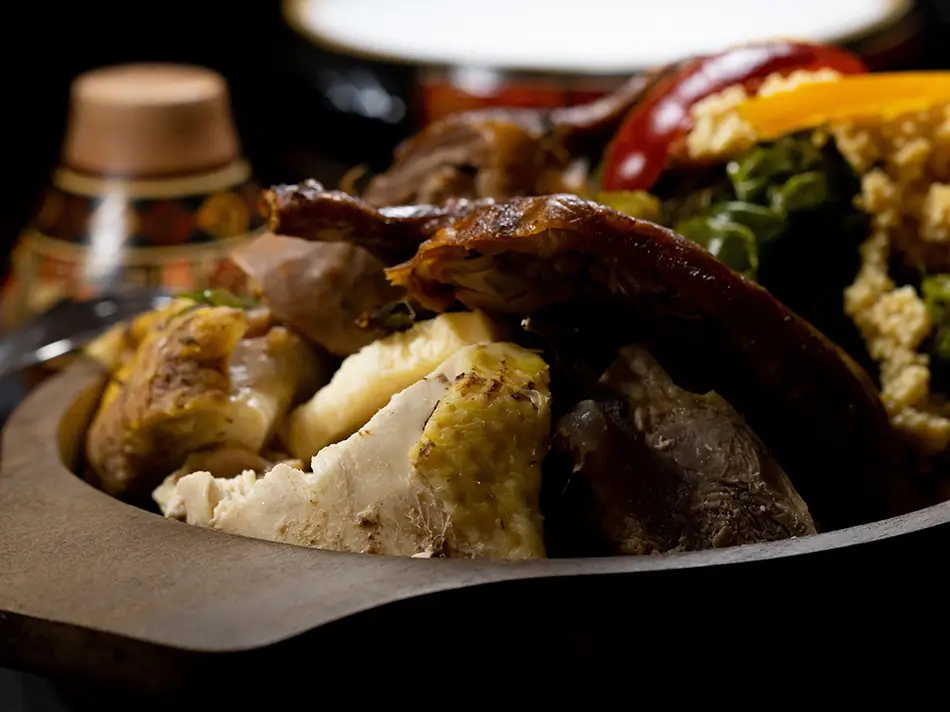
A signature dish from Cusco, Chiriuchu is traditionally served cold during the Corpus Christi festival. The name means “cold chili” in the Quechua language. It is a platter that brings together a variety of ingredients from different regions, including a piece of roasted cuy (guinea pig), chicken, charqui (dried meat), corn tortillas, cheese, hot peppers, and cochayuyo (seaweed).
5. Cuy Chactado (Fried Guinea Pig)
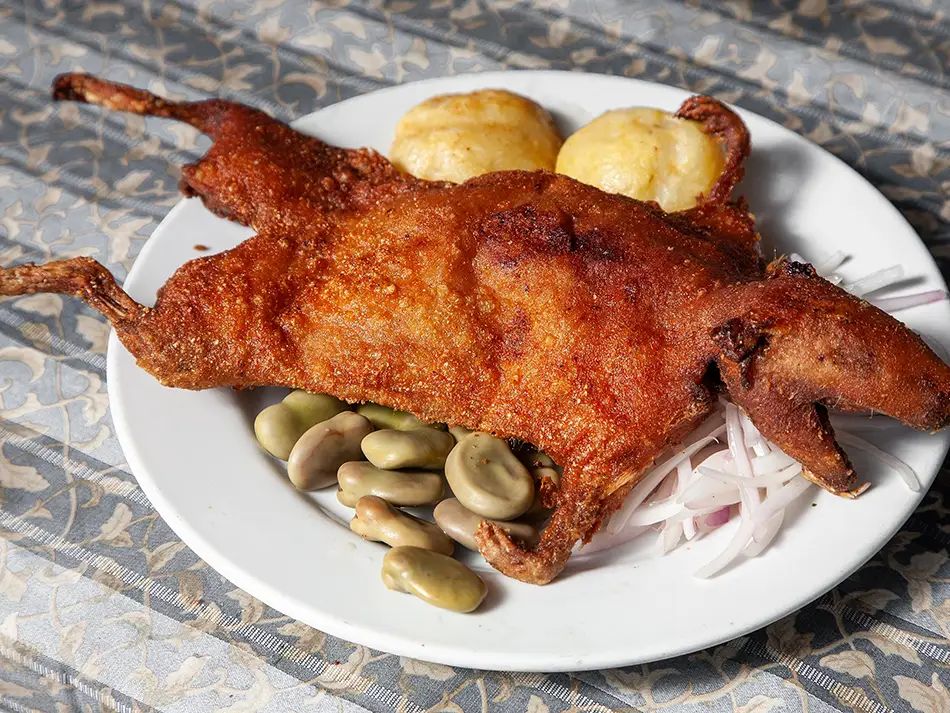
Cuy, or guinea pig, is a traditional source of protein in the Andean highlands. For Cuy Chactado, the whole animal is seasoned, flattened, and then deep-fried under a weight, usually a stone. This technique results in a very crispy skin and moist meat. It is typically served with potatoes or corn.
6. Lomo Saltado (Stir Fried Beef)
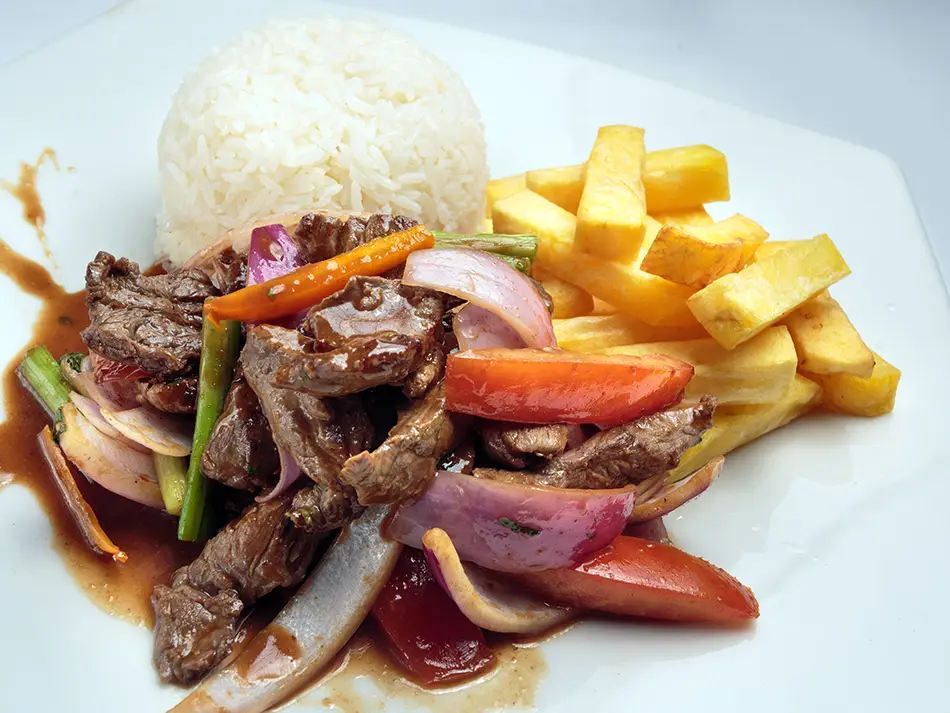
A staple of Chifa, or Chinese-Peruvian fusion cuisine, Lomo Saltado is a stir-fry that combines marinated strips of sirloin or other beef steak with onions, tomatoes, and aji amarillo. The ingredients are flash-cooked in a wok and seasoned with soy sauce and vinegar. It is served with two starches: French fries mixed into the stir-fry and a side of white rice.
7. Pachamanca (Earth Oven Meats)
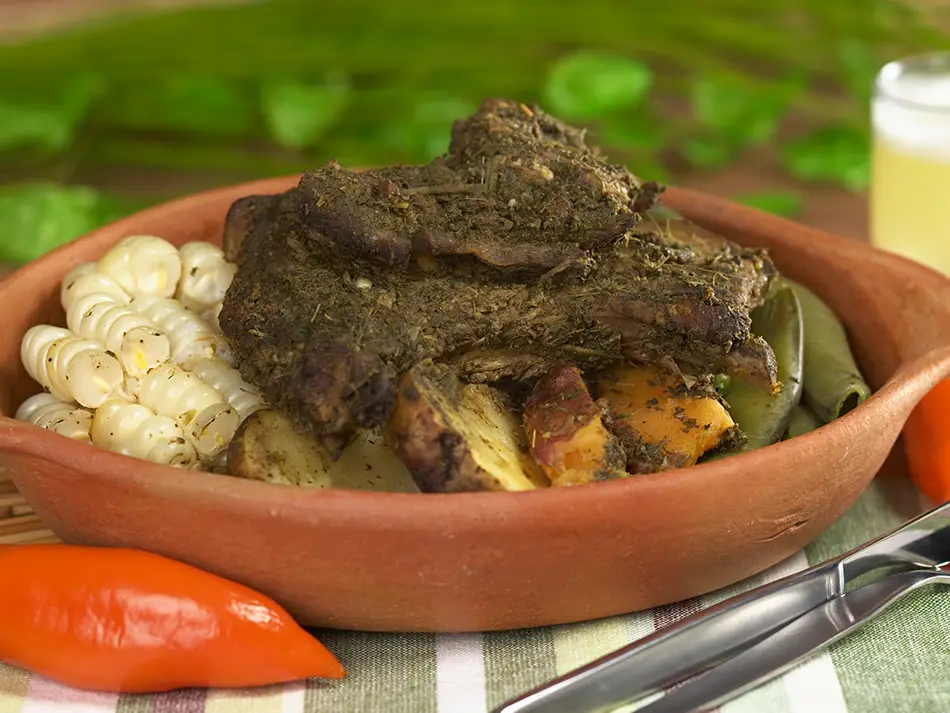
More of a cooking method than a specific dish, Pachamanca is a traditional practice from the Andes. Various types of meat (like lamb, pork, and chicken), potatoes, sweet potatoes, corn, and fava beans are marinated in herbs and spices. They are then placed in a pit lined with hot stones, covered with leaves and earth, and left to cook slowly. This “earth oven” technique infuses the food with a smoky, earthy flavor.
8. Rocoto Relleno (Stuffed Hot Pepper)
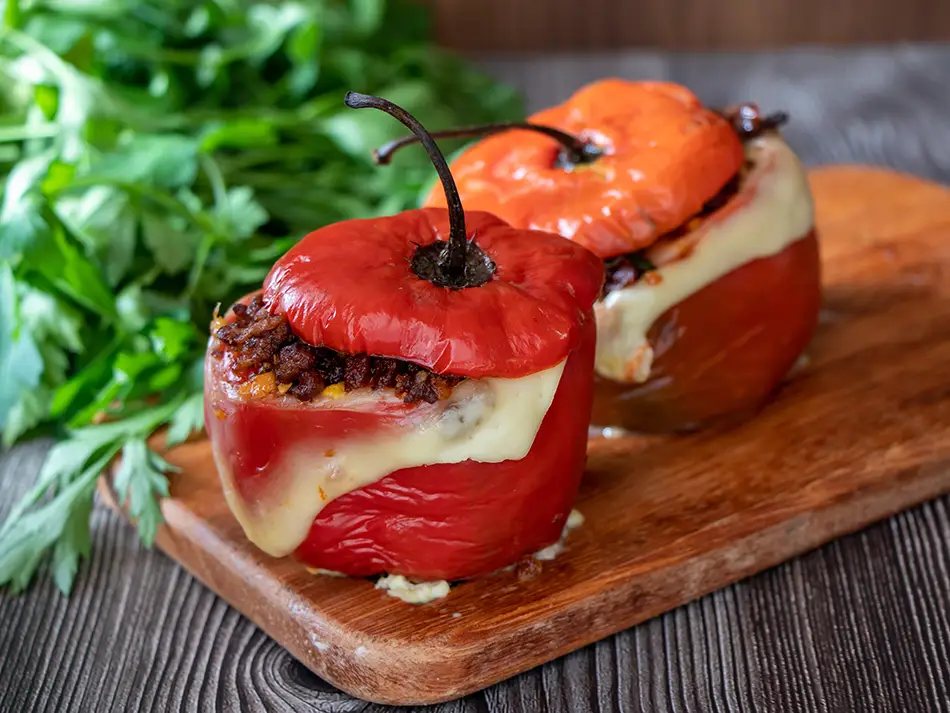
Originating from Arequipa, this dish features the rocoto pepper, a spicy, red pepper similar in appearance to a bell pepper but with significant heat. The pepper is hollowed out, boiled to reduce its spiciness, and then stuffed with a savory mixture of minced meat, onions, peanuts, olives, and spices. It is topped with cheese and baked, often served with a side of layered, baked potatoes known as pastel de papa.
9. Tacacho con Cecina (Plantain Mash With Pork)

Another specialty from the Amazon region, this dish pairs two distinct components. Tacacho consists of mashed, roasted green plantains mixed with pork fat, then shaped into balls. Cecina is salted and sun-dried pork that is then smoked or fried, resulting in a firm, flavorful meat. The combination of the starchy, savory tacacho and the salty cecina is a core part of the local diet.
10. Cau Cau (Tripe Potato)
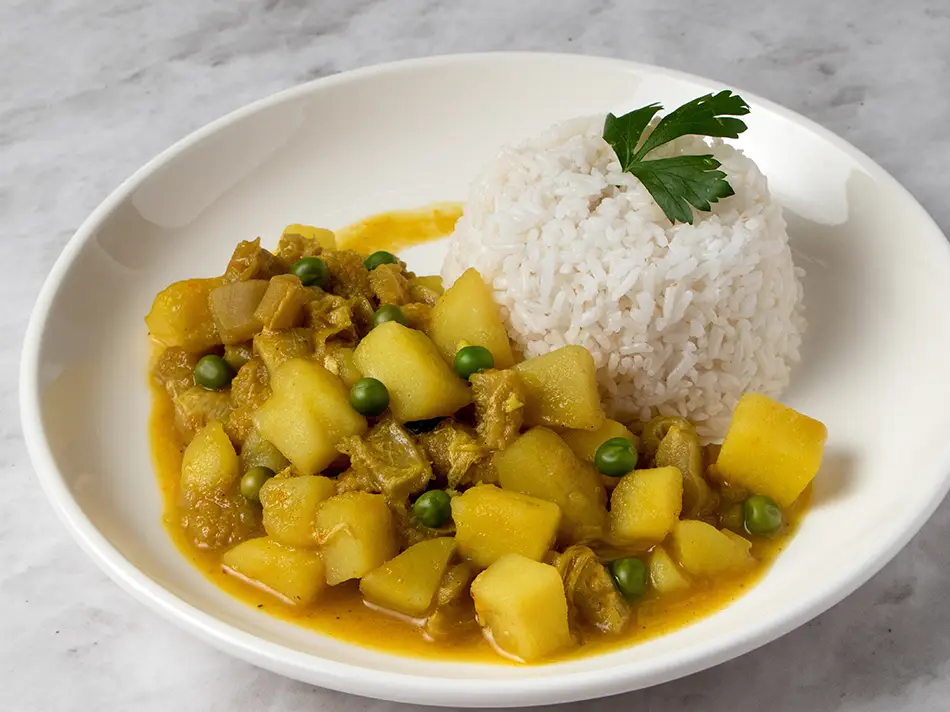
This tripe stew has Afro-Peruvian origins. It is made with diced beef tripe, cooked until tender, and combined with potatoes in a sauce seasoned with aji amarillo, turmeric (for color), mint, and onions. It is a comforting dish, typically served with a side of white rice.
Soups & Stews to Add to Your Peru Food List
11. Adobo Arequipeño (Marinated Pork Stew)
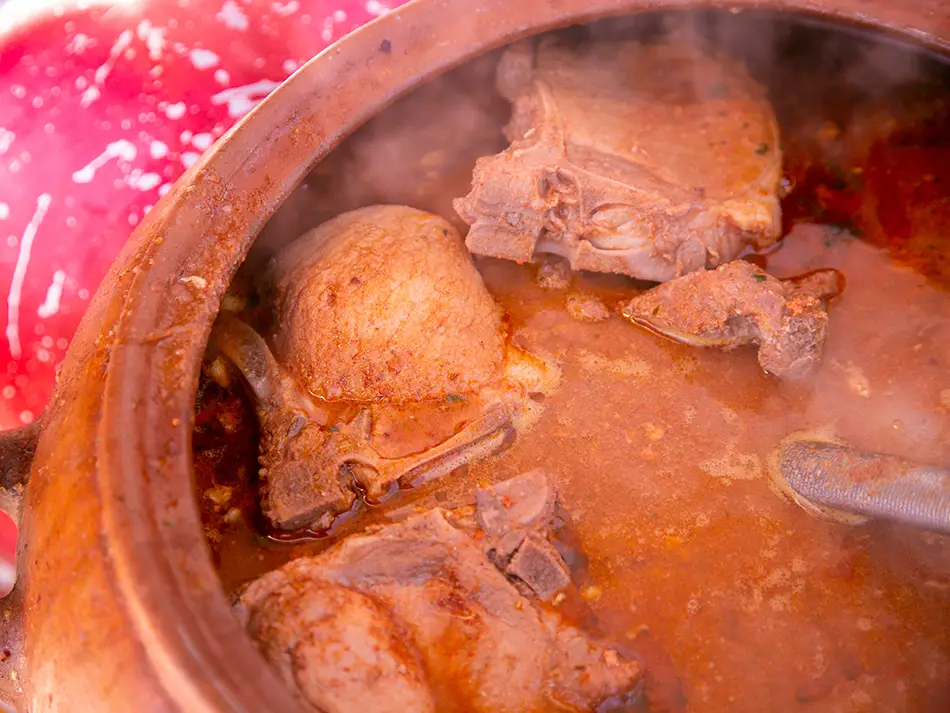
This is a hearty pork stew from the Arequipa region, traditionally eaten for breakfast on Sundays. Pork loin is marinated and slow-cooked in a broth of chicha de jora (a fermented corn beer), aji panca, garlic, and cumin. The result is tender meat in a tangy, slightly spicy sauce, usually served with bread for dipping.
12. Caldo de Carachama (Amazon Catfish Soup)

A staple soup from the Amazon jungle, this dish is made with the carachama, an armored catfish native to the region’s rivers. The fish is cooked in a simple broth with local vegetables and herbs, often including cilantro and sachaculantro (a local variety of cilantro). The soup has a distinct, fresh flavor reflective of its environment.
13. Chairo (Andean Beef Soup)
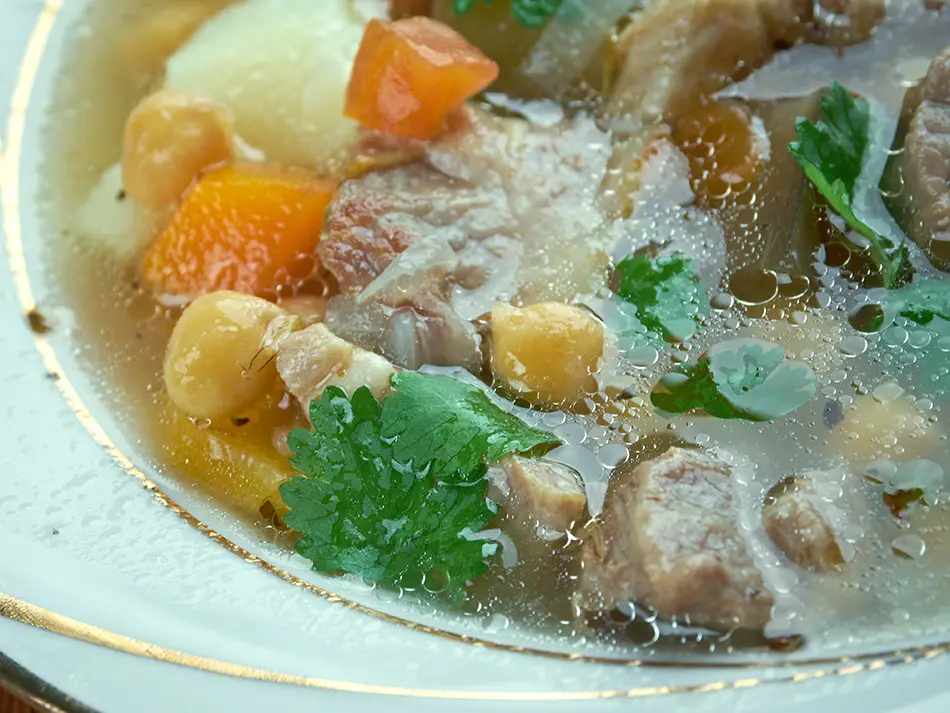
Chairo is a nourishing and dense soup from the Puno and Cusco regions of the Andes. It is made with a base of lamb or beef broth and includes a variety of ingredients like chuño (freeze-dried potato), wheat, fava beans, carrots, and pieces of meat. Its thick consistency and mix of grains and vegetables make it a complete meal.
14. Chupe de Camarones (Shrimp Chowder)

A substantial shrimp chowder from the coastal region, particularly Arequipa, this dish is creamy and reddish in color, built on a base of shrimp stock, aji panca, and milk. Whole shrimp join potatoes, broad beans, corn, and rice, while a poached egg adds richness. The bowl is finished with a piece of fresh cheese, creating a complex and filling one-pot meal.
15. Inchicapi (Peanut Chicken Soup)
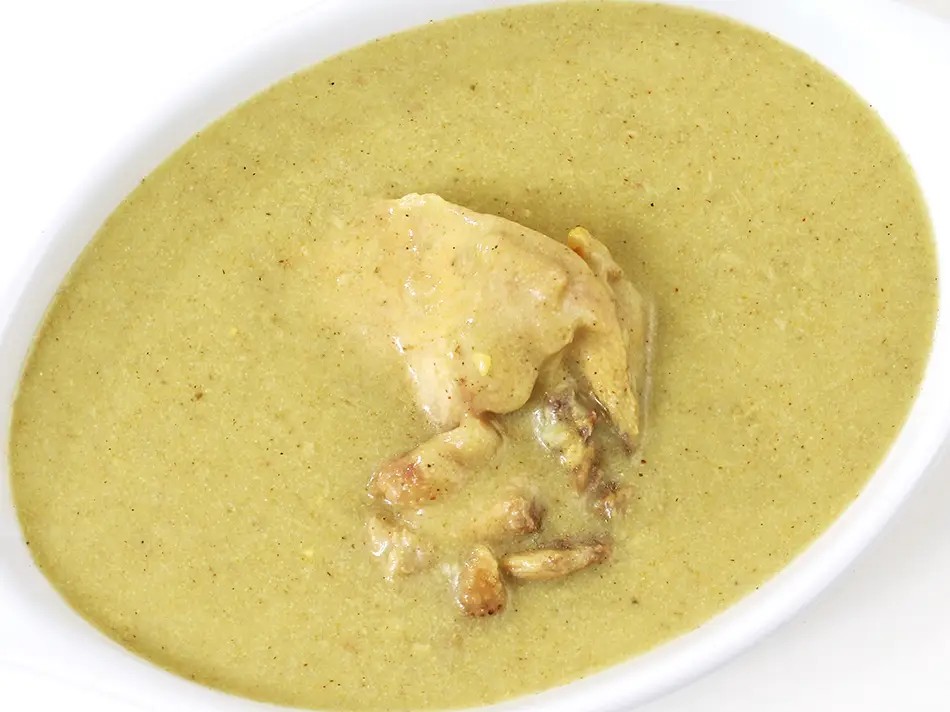
A traditional soup from the Peruvian jungle, Inchicapi gets its name from the Quechua words for “peanut” and “soup.” It is a thick, creamy soup made from ground peanuts and hen or chicken broth, thickened with manioc (yuca) or cornmeal. It is flavored with sachaculantro, giving it a unique aromatic quality.
16. Parihuela (Seafood Soup)
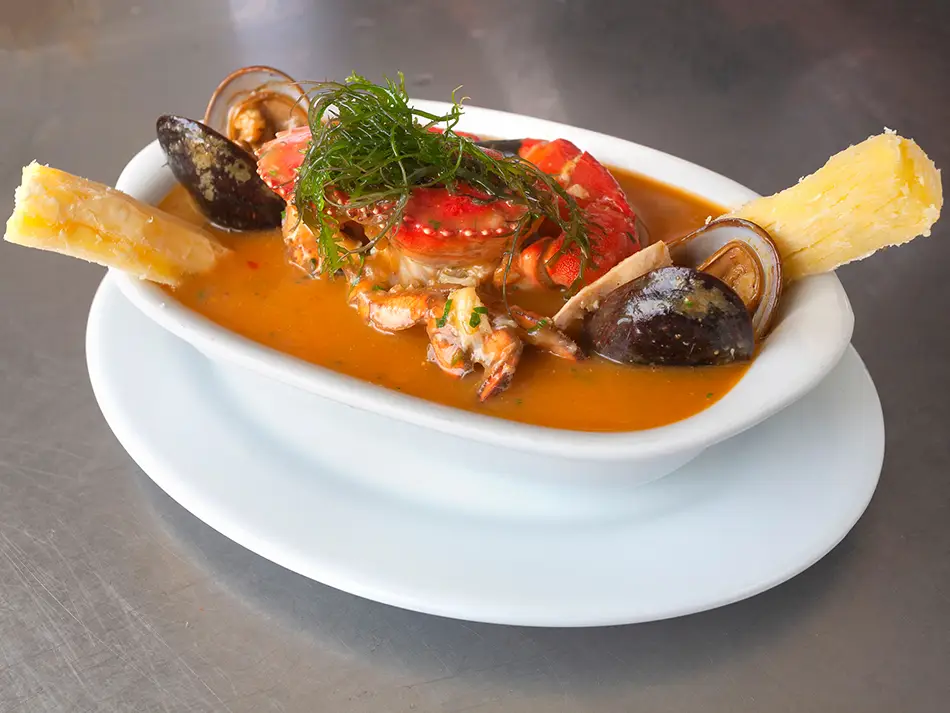
This is a robust and spicy seafood soup from the coast, often referred to as the local version of bouillabaisse. It is made with a tomato and aji panca base and loaded with a variety of fresh fish and shellfish, such as crab, mussels, and clams. A splash of pisco, a local grape brandy, is often added at the end of cooking.
17. Shambar (Wheat And Bean Soup)
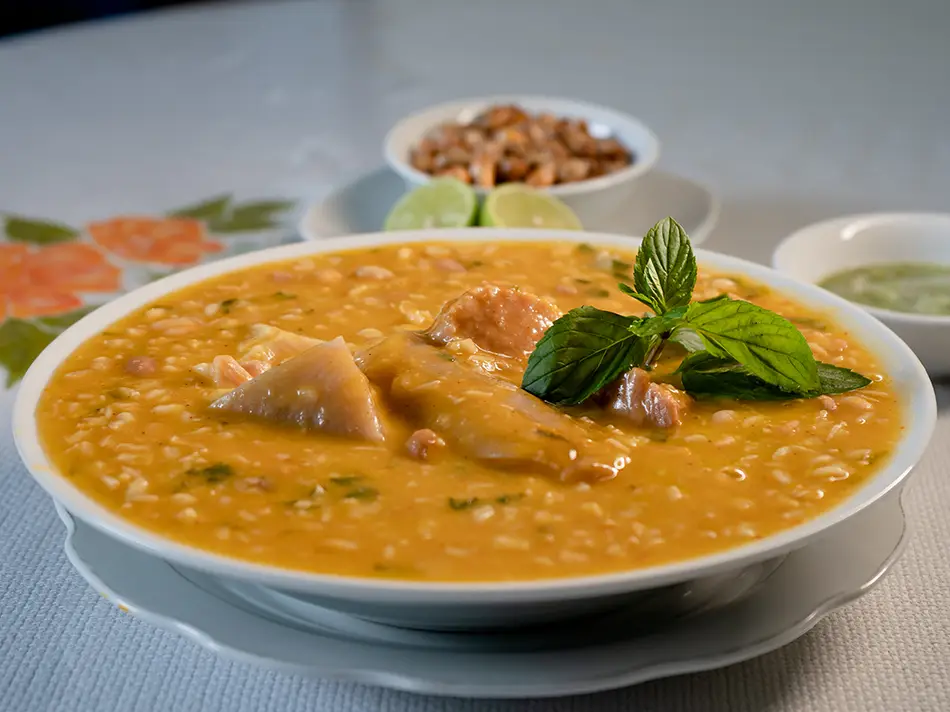
A traditional Monday soup from the city of Trujillo in the north. Shambar is a thick, legume-based soup containing a mix of grains like wheat, chickpeas, and beans. It also includes different types of smoked pork, such as ribs and skin. The soup is seasoned with herbs and is known for being very filling.
Small Plates & Cold Dishes: Must-Try Food in Peru
18. Anticuchos de Corazón (Beef Heart Skewers)
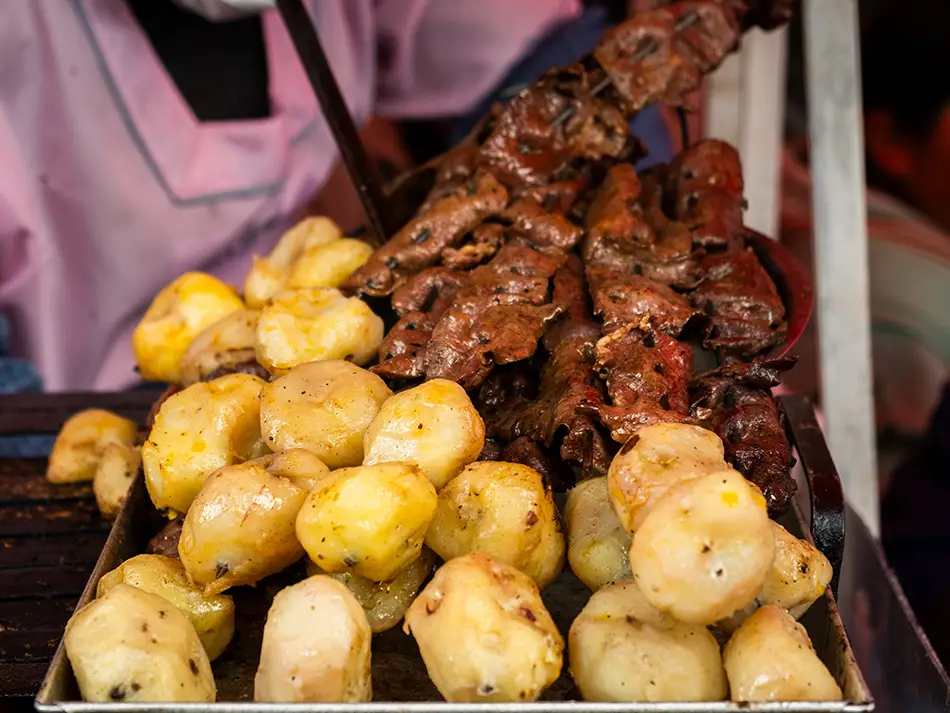
A popular street food, Anticuchos are skewers of marinated meat. The most traditional version is Anticuchos de Corazón, made with beef heart. The heart is cut into cubes, marinated in a mixture of vinegar, cumin, garlic, and aji panca, then grilled over charcoal. They are typically served with a boiled potato and a corn on the cob.
19. Causa Rellena (Layered Potato Salad)
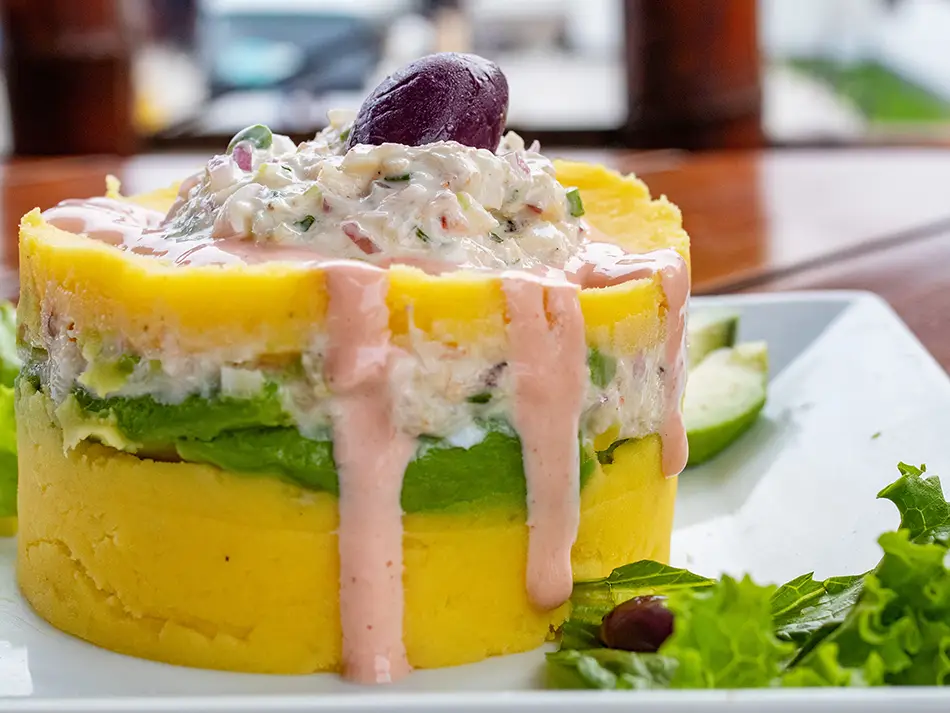
Causa Rellena is a layered dish served cold. It is made with seasoned, mashed yellow potatoes, which are layered with a filling. The potato mash is colored with aji amarillo, and the filling commonly consists of shredded chicken, tuna, or seafood mixed with mayonnaise. It is often garnished with avocado, olives, and hard-boiled eggs.
20. Ceviche (Citrus Cured Fish)
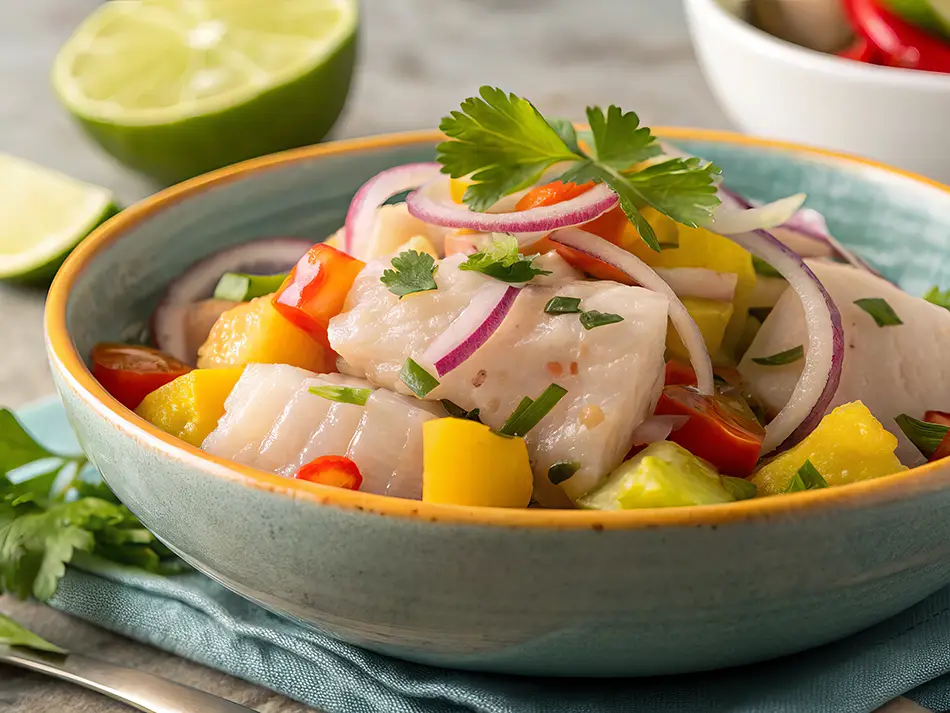
This is the country’s national dish. Ceviche consists of raw fish cut into bite-sized pieces and marinated in a mixture of lime juice, onion, salt, and chili peppers (aji). The acidity of the lime juice “cooks” the fish. It is traditionally served with slices of sweet potato, choclo (large-kernel corn), and sometimes cancha (toasted corn kernels).
21. Choritos a la Chalaca (Mussels With Salsa)
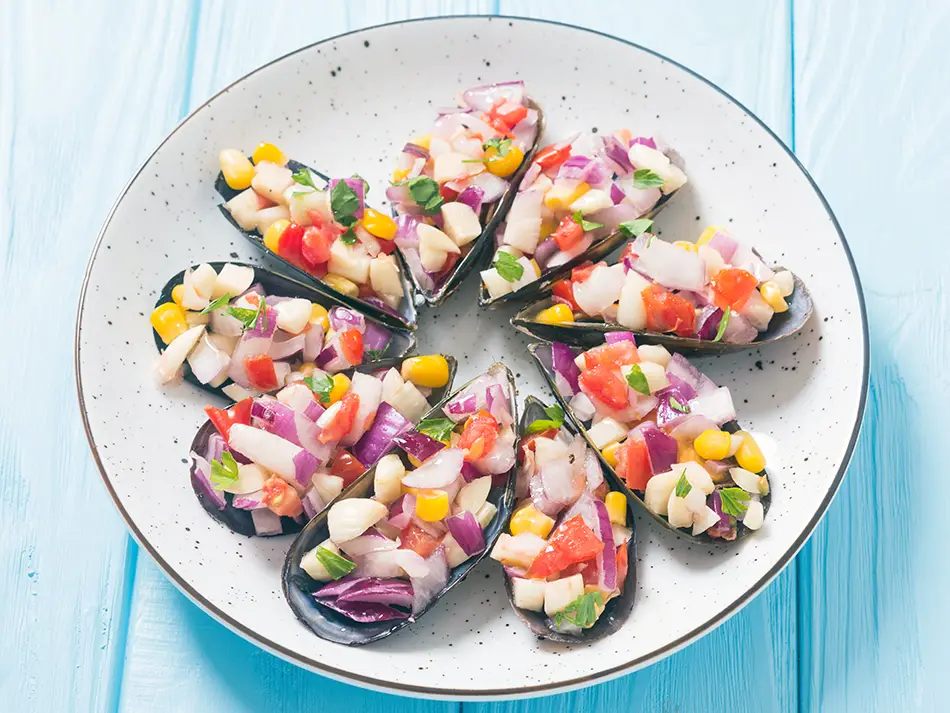
A simple and refreshing appetizer from the port city of Callao. “Choritos” are mussels, and “a la Chalaca” means in the style of Callao. The mussels are steamed, served on the half shell, and topped with a zesty salsa of diced onion, tomato, lime juice, corn kernels, and cilantro.
22. Ensalada de Chonta (Palm Heart Salad)
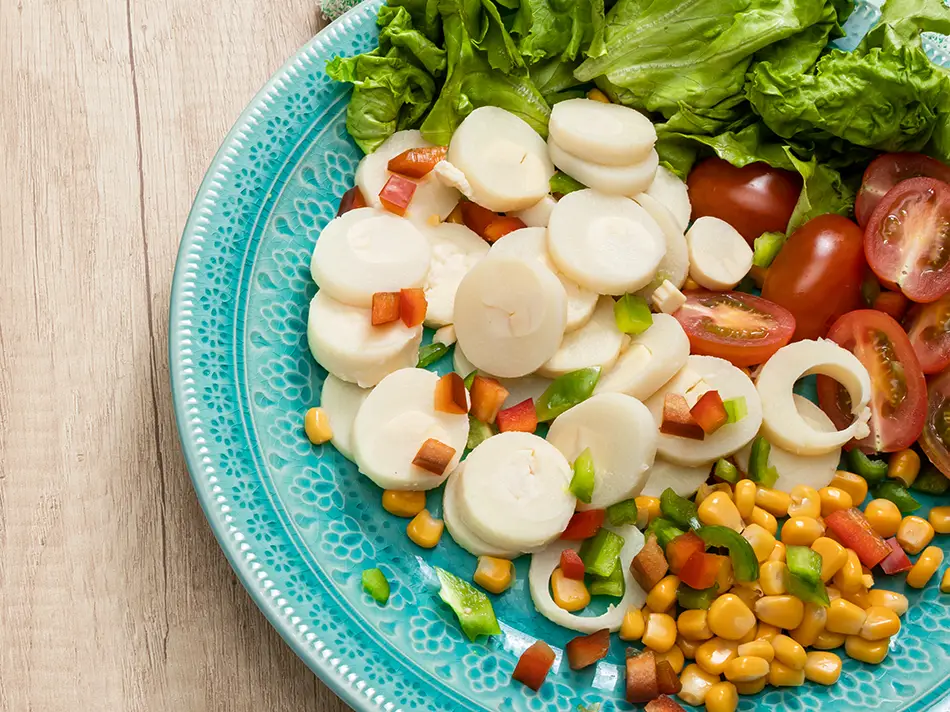
A salad from the Amazon region, its main ingredient is chonta, also known as palm heart. The chonta is shaved into thin, noodle-like strips and has a crisp texture and mild flavor. It is tossed with a simple dressing of lime juice, oil, and sometimes tomatoes and onions, creating a light and refreshing dish.
23. Ocopa Arequipeña (Potatoes With Peanut Sauce)
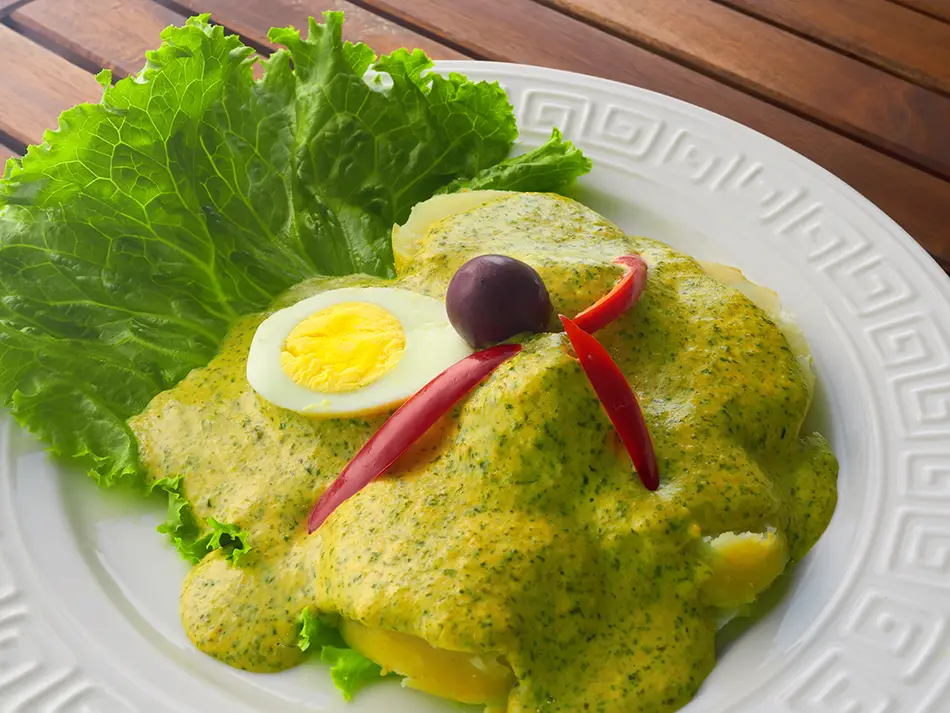
This appetizer consists of boiled potatoes covered in a creamy, green sauce called ocopa. The sauce is made from aji amarillo, a local herb called huacatay (black mint), peanuts or walnuts, and fresh cheese, all blended together. It is typically served cold and garnished with an olive and a hard-boiled egg. The huacatay gives the sauce a distinct, aromatic flavor.
24. Papa a la Huancaína (Potatoes In Cheese Sauce)
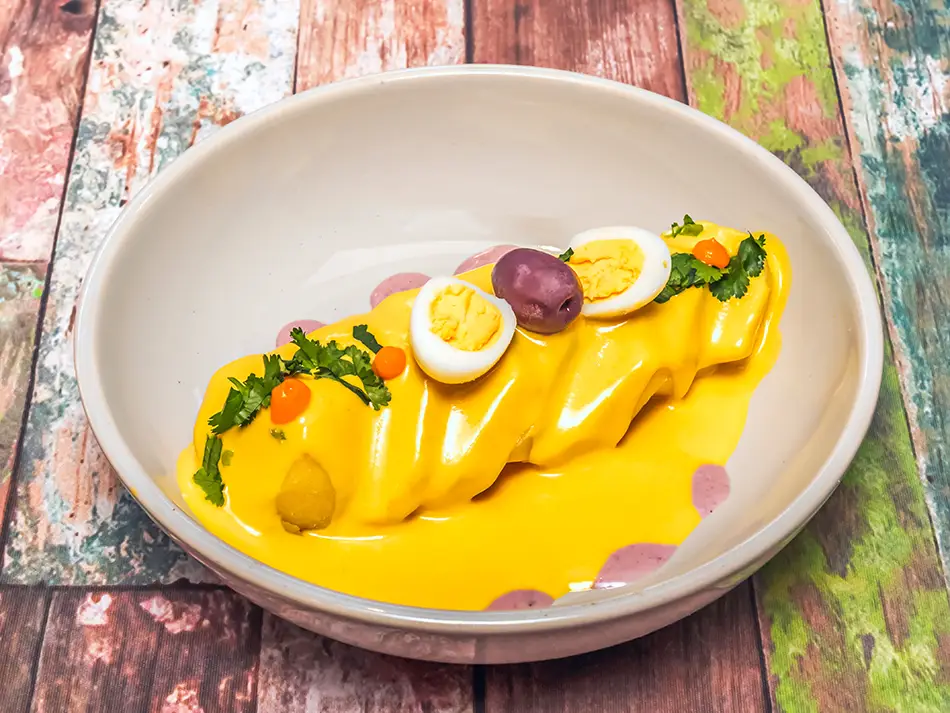
Similar to Ocopa, this dish features boiled potatoes served with a different creamy sauce. The Huancaína sauce is bright yellow and made from fresh cheese, aji amarillo, milk, and saltine crackers, which act as a thickener. It is served chilled over sliced potatoes on a bed of lettuce, garnished with olives and egg.
25. Solterito de Queso (Fava Corn Cheese Salad)
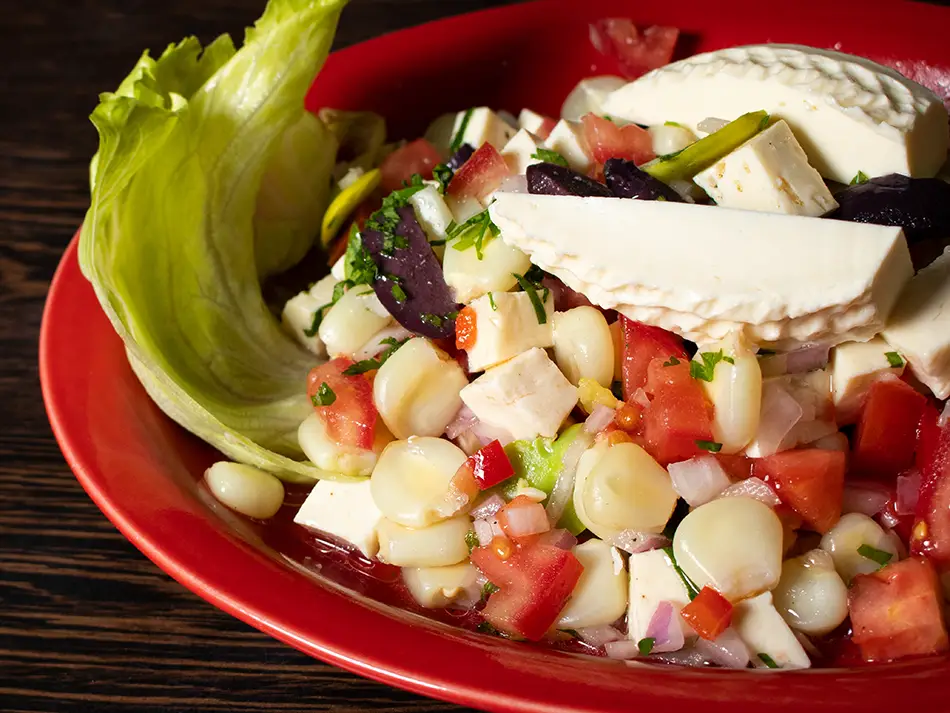
A fresh, chopped salad from Arequipa, its name translates to “little single man’s cheese.” It is a colorful mix of diced queso fresco (fresh white cheese), fava beans, choclo, onions, tomatoes, and sometimes olives. The salad is dressed with lime juice, vinegar, oil, and seasoned with rocoto pepper for a bit of heat.
26. Tiradito (Sliced Raw Fish)
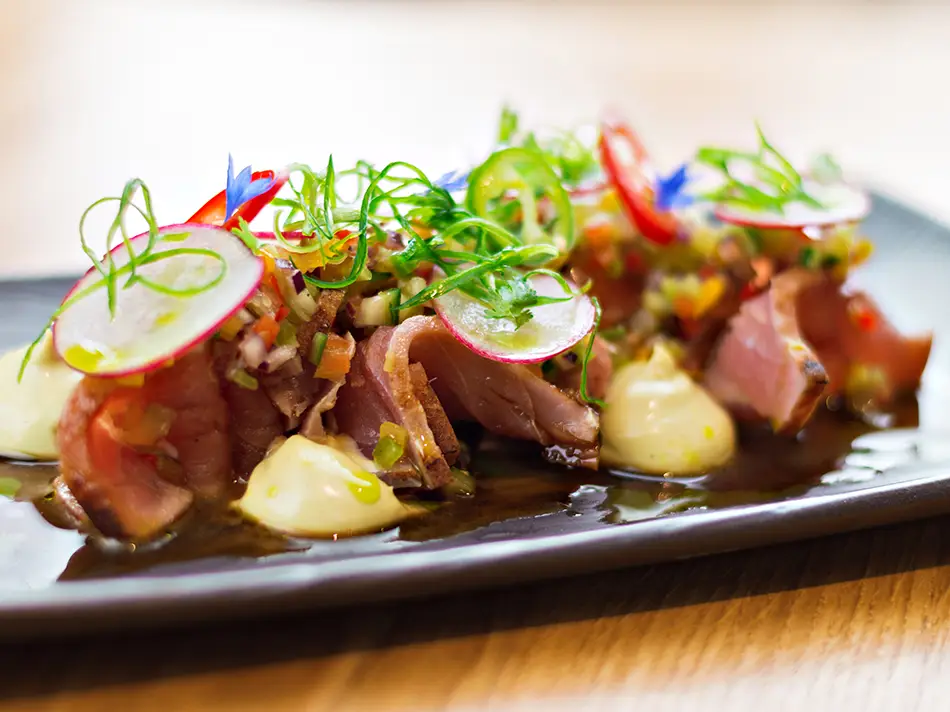
Tiradito is influenced by Japanese immigrants and their sashimi traditions. It consists of thinly sliced raw fish, similar to carpaccio, which is “cooked” just before serving by adding a cold, spicy sauce. Unlike ceviche, it contains no onions. The sauce is often aji amarillo or rocoto-based, and it is a lighter, more delicate dish.
Famous Desserts & Sweets in Peru
27. Guarguero (Cream Filled Pastry)

These are delicate, tube-shaped pastries from the southern region of Moquegua. A thin dough is rolled around a tube and deep-fried until golden and crisp. After cooling, the tubes are filled with manjar blanco (a sweet, milk-based caramel, similar to dulce de leche) and dusted with powdered sugar.
28. King Kong (Layered Cookie Cake)
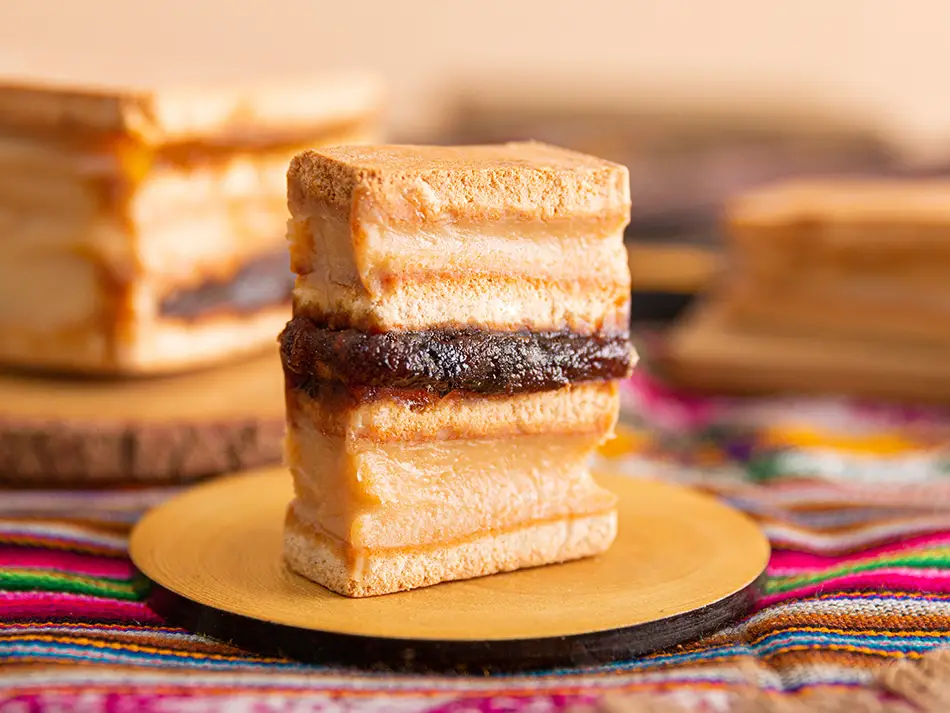
A famously large confection from the northern city of Lambayeque. King Kong is a layered rectangular cookie sandwich. Large, crisp cookies are layered with manjar blanco, pineapple jam, and sometimes peanut nougat. It is sold by weight and is meant for sharing.
29. Mazamorra Morada (Purple Corn Pudding)
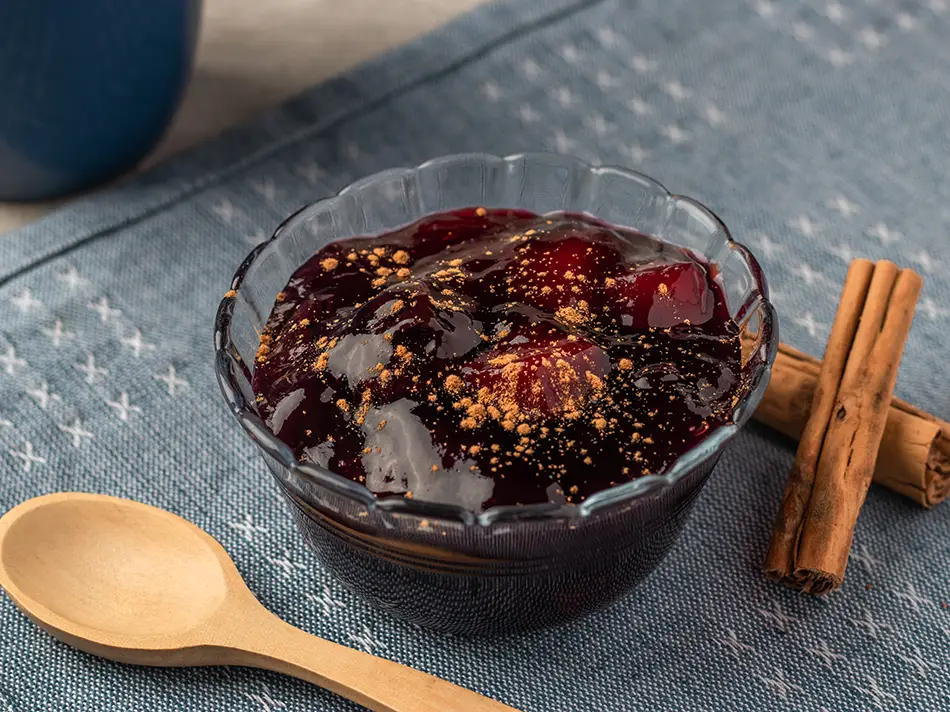
This is a popular pudding-like dessert made from purple corn, the same ingredient used for the drink Chicha Morada. The corn is boiled with fruits like pineapple and quince, then thickened with sweet potato flour. It is spiced with cinnamon and cloves and has a gelatinous texture and a sweet, fruity flavor.
30. Picarones (Sweet Potato Doughnuts)
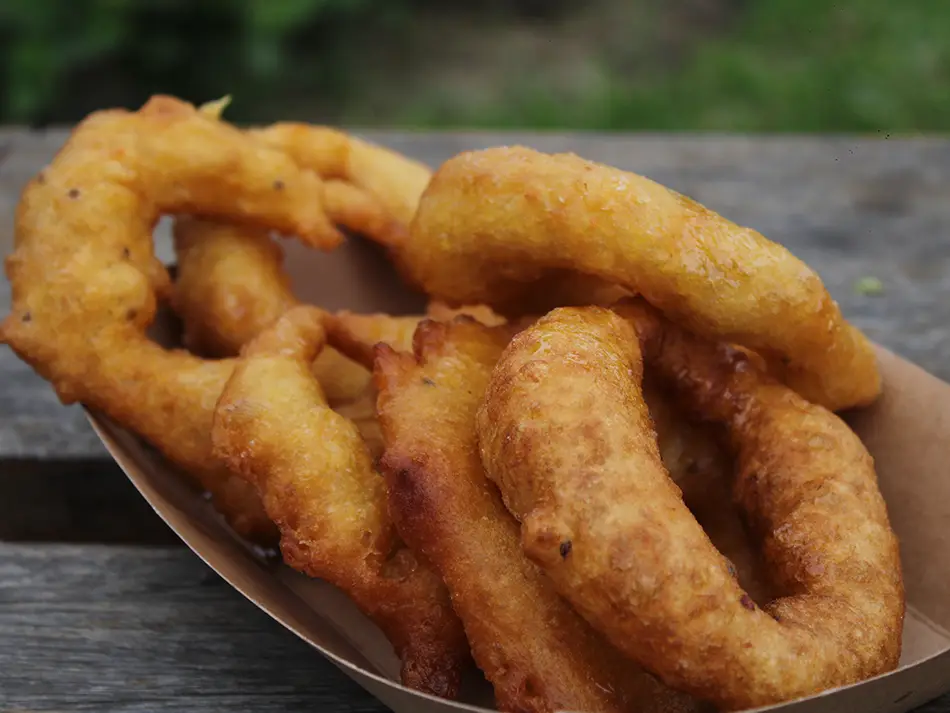
These are ring-shaped fritters that resemble doughnuts. The dough is made from a base of sweet potato and squash, yeasted, and then deep-fried. Instead of a sugar glaze, Picarones are served hot, drenched in a sweet syrup made from chancaca, flavored with orange peel and spices.
31. Suspiro a la Limeña (Caramel Meringue Dessert)
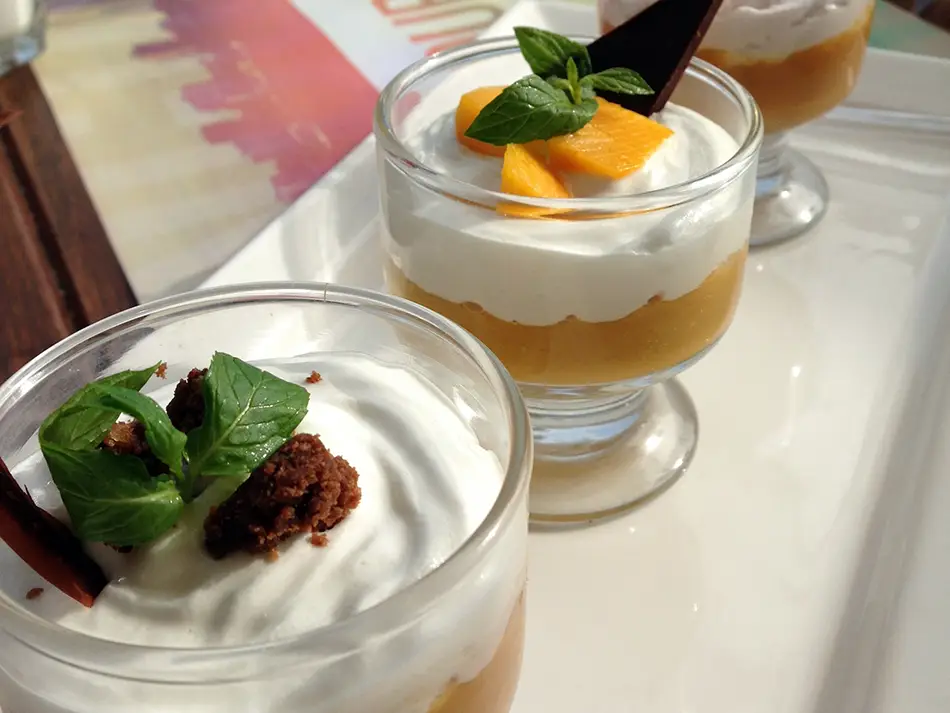
This dessert’s name translates to “sigh of a lady from Lima.” It is a two-layered dessert served in a glass. The bottom layer is a smooth, sweet manjar blanco cream. It is topped with a port wine-infused Italian meringue, which is lighter and stiffer than a standard meringue, and dusted with cinnamon.
32. Turrón de Doña Pepa (Anise Syrup Pastry)
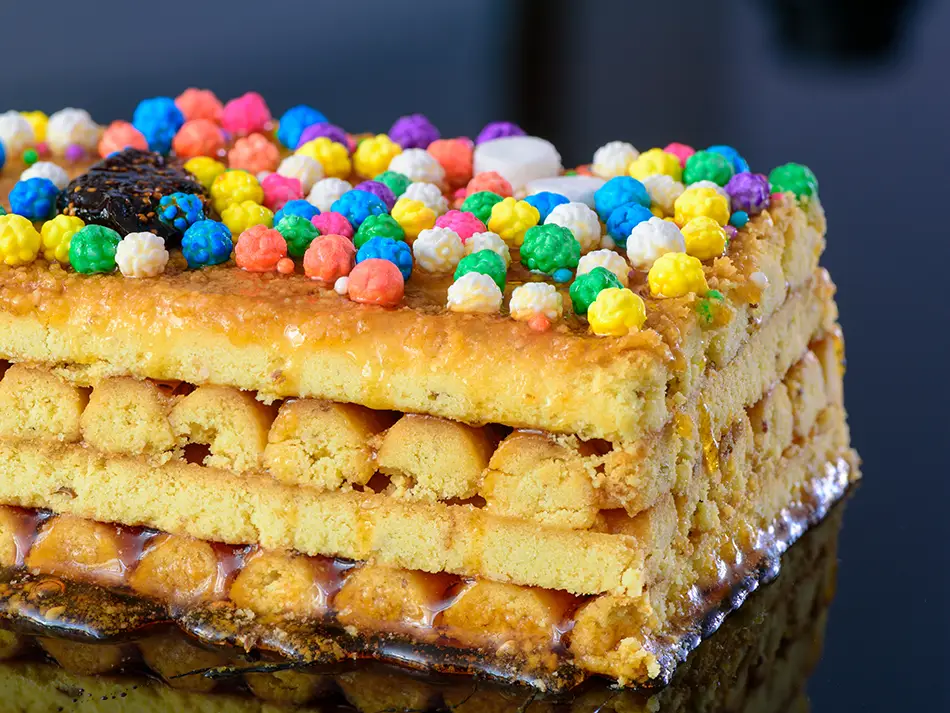
This is a large, sticky nougat-like dessert traditionally prepared for the Lord of Miracles religious festivities in October. It consists of multiple layers of anise-flavored cookie sticks, which are “glued” together with chancaca syrup. The entire block is decorated with colorful, nonpareil-style candies.
Bonus Part: Authentic Drinks in Peru
Leche de Tigre (Ceviche Marinade Shot)

Translating to “tiger’s milk,” Leche de Tigre is the citrus-based marinade used to cure the fish in ceviche. It is a potent, flavorful liquid made from lime juice, fish stock, onion, chili, and cilantro. It is often served on its own as a beverage in a small glass, considered both a hangover cure and an aphrodisiac.
Chicha de Jora (Fermented Corn Beer)

An alcoholic beverage with ancient origins, Chicha de Jora is a fermented beer made from jora, a specific type of germinated maize. It has a cloudy appearance, a slightly sour taste, and varies in strength depending on the fermentation time. It is a culturally significant drink in the Andes.
Chicha Morada (Purple Corn Drink)
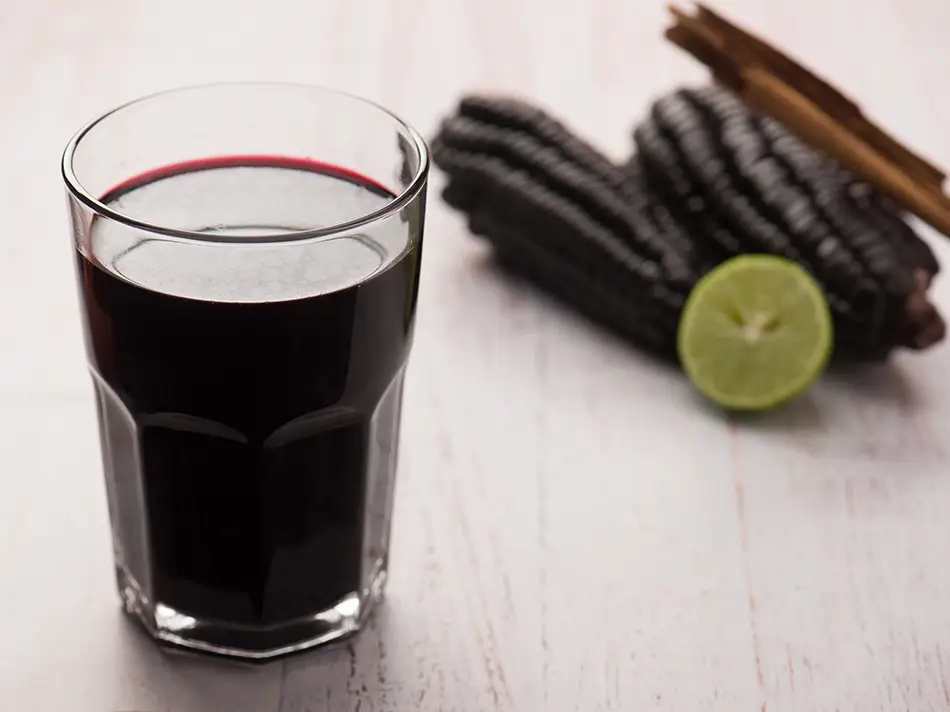
This is a non-alcoholic beverage made from culli, or Peruvian purple corn. The corn is boiled with pineapple rind, quince, cinnamon, and cloves. The resulting liquid is cooled and sweetened with sugar. It is a common and refreshing table drink with a flavor profile similar to a spiced grape juice.
Emoliente (Herbal Barley Tea)
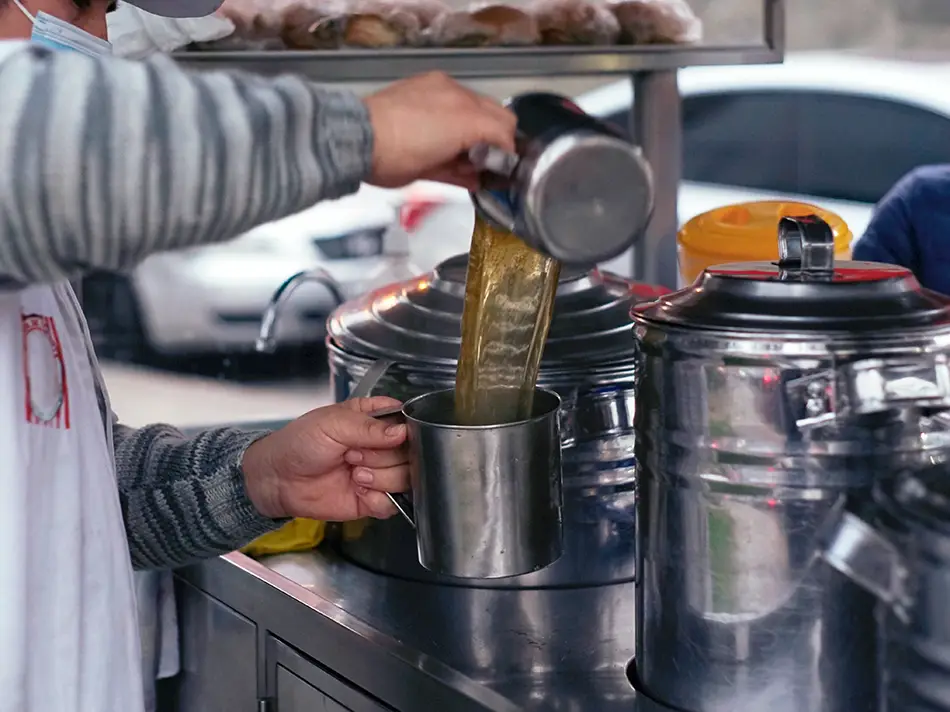
A traditional warm beverage sold by street vendors, especially in the morning or at night. Emoliente is an herbal infusion known for its supposed health benefits. The base is typically toasted barley, but vendors add a variety of plant extracts like flaxseed, alfalfa sprouts, and horsetail herb, customized to the drinker’s preference.
Mate de Coca (Coca Leaf Tea)
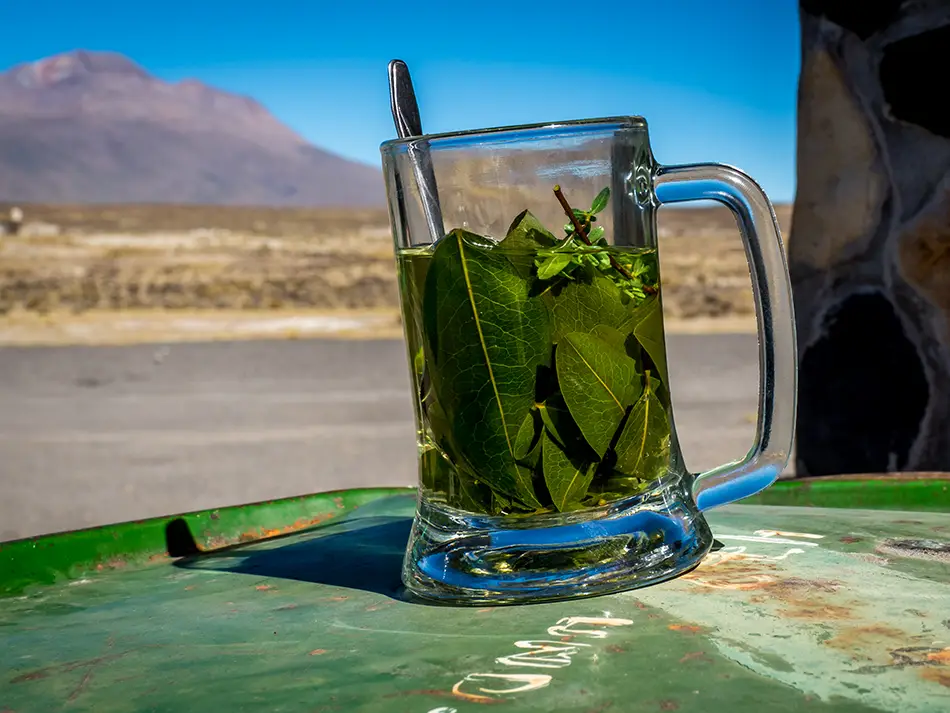
A well-known herbal tea made from coca leaves. Mate de Coca is widely consumed in the Andes to help alleviate the symptoms of altitude sickness. The leaves are steeped in hot water, creating a mild, slightly bitter infusion similar to green tea.
Pisco (Grape Brandy)

This is the national spirit, a type of brandy or aguardiente made by distilling fermented grape juice. It is a clear, unaged spirit with complex, grape-forward aromatics. There are several grape varietals used to make pisco, each resulting in a different flavor profile, from earthy and robust to floral and aromatic.
Pisco Sour (Pisco Lime Cocktail)
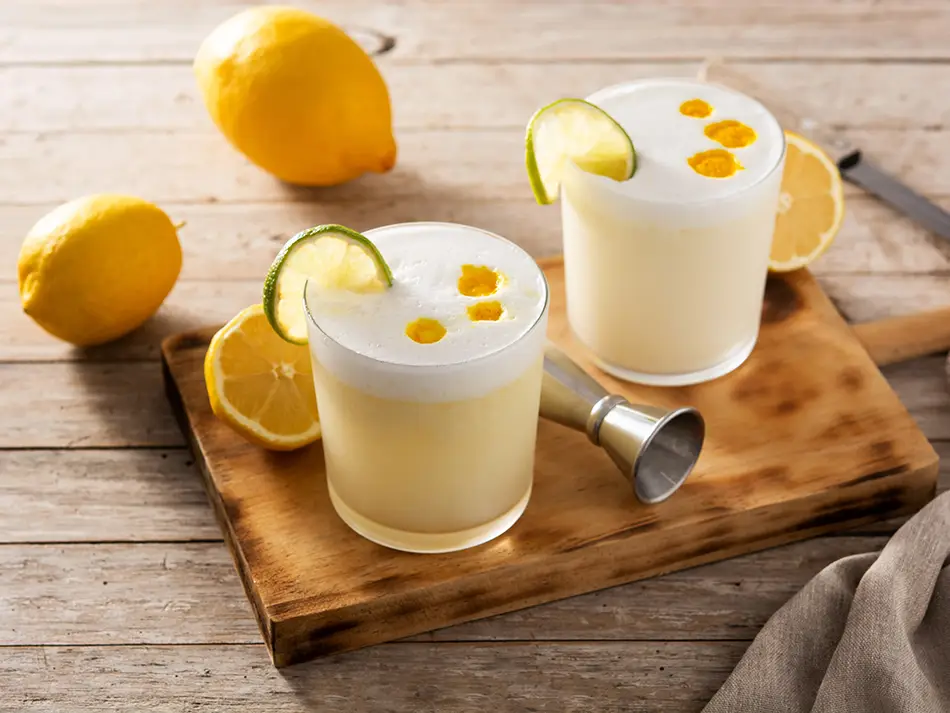
The country’s most famous cocktail. The Pisco Sour is made by shaking pisco with fresh lime juice, simple syrup, and egg white, which gives it a frothy head. It is served straight up in a small glass and garnished with a few drops of Angostura bitters.
Keep Track of Your Gastronomic Trip in Peru
You now have a starting list for exploring one of the world’s most exciting culinary landscapes. From fresh coastal ceviche to hearty Andean stews and vibrant Amazonian specialties, Peru offers an incredible range of flavors and traditions.
To make the most of your trip, download our Best Food in Peru interactive PDF checklist. Use it to tick off each dish you try, add personal notes, and build a unique record of your culinary adventure.
May your travels be rich in flavor and full of unforgettable meals!


